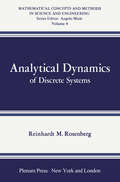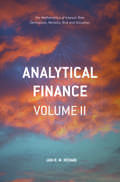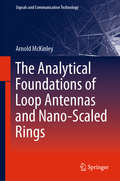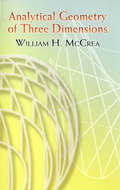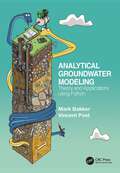- Table View
- List View
Analytical and Numerical Methods for Vibration Analyses
by Jong-Shyong WuIllustrates theories and associated mathematical expressions with numerical examples using various methods, leading to exact solutions, more accurate results, and more computationally efficient techniques This book presents the derivations of the equations of motion for all structure foundations using either the continuous model or the discrete model. This mathematical display is a strong feature of the book as it helps to explain in full detail how calculations are reached and interpreted. In addition to the simple 'uniform' and 'straight' beams, the book introduces solution techniques for the complicated ‘non uniform’ beams (including linear or non-linear tapered beams), and curved beams. Most of the beams are analyzed by taking account of the effects of shear deformation and rotary inertia of the beams themselves as well as the eccentricities and mass moments of inertia of the attachments. Demonstrates approaches which dramatically cut CPU times to a fraction of conventional FEM Presents "mode shapes" in addition to natural frequencies, which are critical for designers Gives detailed derivations for continuous and discrete model equations of motions Summarizes the analytical and numerical methods for the natural frequencies, mode shapes, and time histories of straight structures rods shafts Euler beams strings Timoshenko beams membranes/thin plates Conical rods and shafts Tapered beams Curved beams Has applications for students taking courses including vibration mechanics, dynamics of structures, and finite element analyses of structures, the transfer matrix method, and Jacobi method This book is ideal for graduate students in mechanical, civil, marine, aeronautical engineering courses as well as advanced undergraduates with a background in General Physics, Calculus, and Mechanics of Material. The book is also a handy reference for researchers and professional engineers.
Analytical and Stochastic Modeling Techniques and Applications: 18th International Conference, ASMTA 2011, Venice, Italy, June 20-22, 2011, Proceedings (Lecture Notes in Computer Science #6751)
by Khalid Al-Begain Simonetta Balsamo Dieter Fiems Andrea MarinThis book constitutes the refereed proceedings of the 18th International Conference on Analytical and Stochastic Modeling Techniques and Applications, ASMTA 2011, held in Venice, Italyin June 2011.The 24 revised full papers presented were carefully reviewed and selected from many submissions.The papers are organized in topical sections on queueing theory, software and computer systems, statistics and inference, telecommunication networks, and performance and performability.
Analytical and Stochastic Modeling Techniques and Applications: 17th International Conference, ASMTA 2010, Cardiff, UK, June 14-16, 2010, Proceedings (Lecture Notes in Computer Science #6148)
by Khalid Al-Begain Dieter Fiems William KnottenbeltAnalytical and Stochastic Modeling Techniques and Applications: 19th International Conference, ASMTA 2012, Grenoble, France, June 4-6, 2012. Proceedings (Lecture Notes in Computer Science #7314)
by Khalid Al-Begain Dieter Fiems Jean-Marc VincentThis book constitutes the refereed proceedings of the 19th International Conference on Analytical and Stochastic Modelling Techniques and Applications, ASMTA 2012, held in Grenoble, France, in June 2012. The 20 revised full papers presented were carefully reviewed and selected from numerous submissions. The papers are organized in topical sections on queueing systems; networking applications; Markov chains; stochastic modelling.
Analytical and Stochastic Modeling Techniques and Applications: 15th International Conference, ASMTA 2008 Nicosia, Cyprus, June 4-6, 2008 Proceedings (Lecture Notes in Computer Science #5055)
by Khalid Al-Begain Armin Heindl Miklos TelekAnalytical and Stochastic Modeling Techniques and Applications: 20th International Conference, ASMTA 2013, Ghent, Belgium, July 8-10, 2013, Proceedings (Lecture Notes in Computer Science #7984)
by Alexander Dudin Koen De TurckThis book constitutes the refereed proceedings of the 20th International Conference on Analytical and Stochastic Modelling and Applications, ASMTA 2013, held in Ghent, Belgium, in July 2013. The 32 papers presented were carefully reviewed and selected from numerous submissions. The focus of the papers is on the following application topics: complex systems; computer and information systems; communication systems and networks; wireless and mobile systems and networks; peer-to-peer application and services; embedded systems and sensor networks; workload modelling and characterization; road traffic and transportation; social networks; measurements and hybrid techniques; modeling of virtualization; energy-aware optimization; stochastic modeling for systems biology; biologically inspired network design.
Analytical and Stochastic Modelling Techniques and Applications: 25th International Conference, ASMTA 2019, Moscow, Russia, October 21–25, 2019, Proceedings (Lecture Notes in Computer Science #12023)
by Marco Gribaudo Eduard Sopin Irina KochetkovaThis book constitutes the refereed proceedings of the 25th International Conference on Analytical and Stochastic Modelling Techniques and Applications, ASMTA 2019, held in Moscow, Russia, in October 2019. Methods of analytical and stochastic modelling are widely used in engineering to assess and design various complex systems, like computer and communication networks, and manufacturing systems. The 13 full papers presented in this book were carefully reviewed and selected from 22 submissions. The papers detail a diverse range of analysis techniques, including Markov processes, queueing theoretical results, reliability of stochastic systems, stochastic network calculus, and wide variety of applications.
Analytical and Stochastic Modelling Techniques and Applications: 21st International Conference, ASMTA 2014, Budapest, Hungary, June 30 -- July 2, 2014,Proceedings (Lecture Notes in Computer Science #8499)
by Bruno Sericola Telek Miklós Gábor HorváthThis book constitutes the refereed proceedings of the 21st International Conference on Analytical and Stochastic Modelling Techniques and Applications, ASMTA 2014, held in Budapest, Hungary, in June/July 2014. The 18 papers presented were carefully reviewed and selected from 27 submissions. The papers discuss the latest developments in analytical, numerical and simulation algorithms for stochastic systems, including Markov processes, queueing networks, stochastic Petri nets, process algebras, game theory, etc.
Analytical and Stochastic Modelling Techniques and Applications: 24th International Conference, ASMTA 2017, Newcastle-upon-Tyne, UK, July 10-11, 2017, Proceedings (Lecture Notes in Computer Science #10378)
by Nigel Thomas Matthew ForshawThis book constitutes the refereed proceedings of the 24th International Conference on Analytical and Stochastic Modelling Techniques and Applications, ASMTA 2017, held in Newcastle-upon-Tyne UK, in July 2017.The 14 full papers presented in this book were carefully reviewed and selected from 27 submissions. The scope of the conference is on following topics: analytical, numerical and simulation algorithms for stochastic systems, including Markov processes, queueing networks, stochastic Petri nets, process algebras, game theoretical models.
Analytical Corporate Finance (Springer Texts in Business and Economics)
by Angelo CorelliThis book draws readers’ attention to the financial aspects of daily life at a corporation by combining a robust mathematical setting and the explanation and derivation of the most popular models of the firm. Intended for third-year undergraduate students of business finance, quantitative finance, and financial mathematics, as well as first-year postgraduate students, it is based on the twin pillars of theory and analytics, which merge in a way that makes it easy for students to understand the exact meaning of the concepts and their representation and applicability in real-world contexts. Examples are given throughout the chapters in order to clarify the most intricate aspects; where needed, there are appendices at the end of chapters, offering additional mathematical insights into specific topics. Due to the recent growth in knowledge demand in the private sector, practitioners can also profit from the book as a bridge-builder between university and industry. Lastly, the book provides useful information for managers who want to deepen their understanding of risk management and come to recognize what may have been lacking in their own systems.
Analytical Decision-Making Methods for Evaluating Sustainable Transport in European Corridors (SxI - Springer for Innovation / SxI - Springer per l'Innovazione #11)
by Isabella M. LamiEurocorridors are characterized by intensive transport flows and dynamic patterns of establishment and household locations. They are also considered the backbones of powerful spatial and economic forces in the areas that connect urban regions. One of the main difficulties in the spatial planning of eurocorridors has been the need to engage in different types of collective action. Such an approach can be extremely challenging in practice, useful to researchers in the field and to professionals as well. In the light of this, the book’s main objectives are: - To define the problem by analyzing the key features, which include freight and passenger transport policies and issues; the territorial context, with its geographical, social, economic and cultural aspects; the plurality of subjects with different aims and resources and the lack of homogeneous information. - To illustrate assessment models and evaluation frameworks (MCDA; Discrete Choice Analysis; Collaborative Assessments; Geovisualization Technologies) in theoretical terms and by the use of case studies.
Analytical Dynamics of Discrete Systems (Mathematical Concepts and Methods in Science and Engineering)
by R. RosenbergThis book is to serve as a text for engineering students at the senior or beginning graduate level in a second course in dynamics. It grew out of many years experience in teaching such a course to senior students in mechanical engineering at the University of California, Berkeley. While temperamentally disinclined to engage in textbook writing, I nevertheless wrote the present volume for the usual reason-I was unable to find a satisfactory English-language text with the content covered in my inter mediate course in dynamics. Originally, I had intended to fit this text very closely to the content of my dynamics course for seniors. However, it soon became apparent that that course reflects too many of my personal idiosyncracies, and perhaps it also covers too little material to form a suitable basis for a general text. Moreover, as the manuscript grew, so did my interest in certain phases of the subject. As a result, this book contains more material than can be studied in one semester or quarter. My own course covers Chapters 1 to 5 (Chapters 1,2, and 3 lightly) and Chapters 8 to 20 (Chapter 17 lightly).
Analytical Finance: The Mathematics of Equity Derivatives, Markets, Risk and Valuation
by Jan R. RömanThis book provides an introduction to the valuation of financial instruments on equity markets. Written from the perspective of trading, risk management and quantitative research functions and written by a practitioner with many years’ experience in markets and in academia, it provides a valuable learning tool for students and new entrants to these markets.Coverage includes:·Trading and sources of risk, including credit and counterparty risk, market and model risks, settlement and Herstatt risks.·Numerical methods including discrete-time methods, finite different methods, binomial models and Monte Carlo simulations.·Probability theory and stochastic processes from the financial modeling perspective, including probability spaces, sigma algebras, measures and filtrations.·Continuous time models such as Black-Scholes-Merton; Delta-hedging and Delta-Gamma-hedging; general diffusion models and how to solve Partial Differential Equation using the Feynmann-Kac representation.·The trading, structuring and hedging several kinds of exotic options, including: Binary/Digital options; Barrier options; Lookbacks; Asian options; Chooses; Forward options; Ratchets; Compounded options; Basket options; Exchange and Currency-linked options; Pay later options and Quantos.·A detailed explanation of how to construct synthetic instruments and strategies for different market conditions, discussing more than 30 different option strategies. With source code for many of the models featured in the book provided and extensive examples and illustrations throughout, this book provides a comprehensive introduction to this topic and will prove an invaluable learning tool and reference for anyone studying or working in this field.
Analytical Finance: The Mathematics of Equity Derivatives, Markets, Risk and Valuation
by Jan R. RömanThis book provides an introduction to the valuation of financial instruments on equity markets. Written from the perspective of trading, risk management and quantitative research functions and written by a practitioner with many years’ experience in markets and in academia, it provides a valuable learning tool for students and new entrants to these markets.Coverage includes:·Trading and sources of risk, including credit and counterparty risk, market and model risks, settlement and Herstatt risks.·Numerical methods including discrete-time methods, finite different methods, binomial models and Monte Carlo simulations.·Probability theory and stochastic processes from the financial modeling perspective, including probability spaces, sigma algebras, measures and filtrations.·Continuous time models such as Black-Scholes-Merton; Delta-hedging and Delta-Gamma-hedging; general diffusion models and how to solve Partial Differential Equation using the Feynmann-Kac representation.·The trading, structuring and hedging several kinds of exotic options, including: Binary/Digital options; Barrier options; Lookbacks; Asian options; Chooses; Forward options; Ratchets; Compounded options; Basket options; Exchange and Currency-linked options; Pay later options and Quantos.·A detailed explanation of how to construct synthetic instruments and strategies for different market conditions, discussing more than 30 different option strategies. With source code for many of the models featured in the book provided and extensive examples and illustrations throughout, this book provides a comprehensive introduction to this topic and will prove an invaluable learning tool and reference for anyone studying or working in this field.
Analytical Finance: The Mathematics of Interest Rate Derivatives, Markets, Risk and Valuation
by Jan R. RömanAnalytical Finance is a comprehensive introduction to the financial engineering of equity and interest rate instruments for financial markets. Developed from notes from the author’s many years in quantitative risk management and modeling roles, and then for the Financial Engineering course at Mälardaran University, it provides exhaustive coverage of vanilla and exotic mathematical finance applications for trading and risk management, combining rigorous theory with real market application. Coverage includes:• Date arithmetic’s, quote types of interest rate instruments • The interbank market and reference rates, including negative rates• Valuation and modeling of IR instruments; bonds, FRN, FRA, forwards, futures, swaps, CDS, caps/floors and others • Bootstrapping and how to create interest rate curves from prices of traded instruments• Risk measures of IR instruments• Option Adjusted Spread and embedded options• The term structure equation, martingale measures and stochastic processes of interest rates; Vasicek, Ho-Lee, Hull-While, CIR• Numerical models; Black-Derman-Toy and forward induction using Arrow-Debreu prices and Newton–Raphson in 2 dimension• The Heath-Jarrow-Morton framework• Forward measures and general option pricing models• Black log-normal and, normal model for derivatives, market models and managing exotics instruments• Pricing before and after the financial crisis, collateral discounting, multiple curve framework, cheapest-to-deliver curves, CVA, DVA and FVA
Analytical Finance: The Mathematics of Interest Rate Derivatives, Markets, Risk and Valuation
by Jan R. RömanAnalytical Finance is a comprehensive introduction to the financial engineering of equity and interest rate instruments for financial markets. Developed from notes from the author’s many years in quantitative risk management and modeling roles, and then for the Financial Engineering course at Mälardaran University, it provides exhaustive coverage of vanilla and exotic mathematical finance applications for trading and risk management, combining rigorous theory with real market application. Coverage includes:• Date arithmetic’s, quote types of interest rate instruments • The interbank market and reference rates, including negative rates• Valuation and modeling of IR instruments; bonds, FRN, FRA, forwards, futures, swaps, CDS, caps/floors and others • Bootstrapping and how to create interest rate curves from prices of traded instruments• Risk measures of IR instruments• Option Adjusted Spread and embedded options• The term structure equation, martingale measures and stochastic processes of interest rates; Vasicek, Ho-Lee, Hull-While, CIR• Numerical models; Black-Derman-Toy and forward induction using Arrow-Debreu prices and Newton–Raphson in 2 dimension• The Heath-Jarrow-Morton framework• Forward measures and general option pricing models• Black log-normal and, normal model for derivatives, market models and managing exotics instruments• Pricing before and after the financial crisis, collateral discounting, multiple curve framework, cheapest-to-deliver curves, CVA, DVA and FVA
The Analytical Foundations of Loop Antennas and Nano-Scaled Rings (Signals and Communication Technology)
by Arnold McKinleyThis book develops the analytical theory of perfectly conducting and lossy metal, circular, round-wire loop antennas and nano-scaled rings from the radio frequency (RF) regime through infrared and the optical region. It does so from an antenna theory perspective. It is the first time that all of the historical material found in the literature has appeared in one place. It includes, particularly, material that has appeared in the literature only in the last decade and some new material that has not yet been published. The book derives the input impedance, resonances and anti-resonances, the RLC circuit model representation, and radiation patterns not only of closed loops and rings, but also of loops and rings loaded randomly and multiply with resistive and reactive impedances. Every derivation is compared with simulations run in Microwave Studio (MWS). It looks carefully at the physical response of loop antennas and nano-rings coupled to a source at one point in the periphery and at such rings illuminated by a plane wave arriving from every different direction with the E-field in all polarizations. The book ends with a brief look at polygonal loops, two dimensional arrays of nano-rings, and Yagi-Uda arrays.
Analytical Geometry: Two Dimensions
by Sibdas Karmakar Samiran KarmakarThis book is a compilation of all basic topics of Analytical Geometry of Two Dimensions and is intended to serve as an introductory text aimed towards undergraduate and graduate students in science and technology. An understanding of basic school level algebra and geometry can serve as the prerequisite for following this book. The present work is no original work but an attempt to make the subject thoroughly intelligible. All the important properties of the conics have been discussed either in the articles or in illustrative examples. Each chapter has sufficient completely solved problems and a set of carefully graded and motivating unsolved exercises. Please note: Taylor & Francis does not sell or distribute the Hardback in India, Pakistan, Nepal, Bhutan, Bangladesh and Sri Lanka.
Analytical Geometry: Two Dimensions
by Sibdas Karmakar Samiran KarmakarThis book is a compilation of all basic topics of Analytical Geometry of Two Dimensions and is intended to serve as an introductory text aimed towards undergraduate and graduate students in science and technology. An understanding of basic school level algebra and geometry can serve as the prerequisite for following this book. The present work is no original work but an attempt to make the subject thoroughly intelligible. All the important properties of the conics have been discussed either in the articles or in illustrative examples. Each chapter has sufficient completely solved problems and a set of carefully graded and motivating unsolved exercises. Please note: Taylor & Francis does not sell or distribute the Hardback in India, Pakistan, Nepal, Bhutan, Bangladesh and Sri Lanka.
Analytical Geometry of Three Dimensions: Second Revised Version
by William H. McCreaBrief but rigorous, this text is geared toward advanced undergraduates and graduate students. It covers the coordinate system, planes and lines, spheres, homogeneous coordinates, general equations of the second degree, quadric in Cartesian coordinates, and intersection of quadrics.Mathematician, physicist, and astronomer, William H. McCrea conducted research in many areas and is best known for his work on relativity and cosmology. McCrea studied and taught at universities around the world, and this book is based on a series of his lectures.
Analytical Groundwater Modeling: Theory and Applications using Python
by Mark Bakker Vincent PostThis book provides a detailed description of how Python can be used to give insight into the flow of groundwater based on analytic solutions. Starting with simple problems to illustrate the basic principles, complexity is added step by step to show how one-dimensional and two-dimensional models of one or two aquifers can be implemented. Steady and transient flow problems are discussed in confined, semi-confined, and unconfined aquifers that may include wells, rivers, and areal recharge. Special consideration is given to coastal aquifers, including the effect of tides and the simulation of interface flow. Application of Python allows for compact and readable code, and quick visualization of the solutions. Python scripts are provided to reproduce all results. The scripts are also available online so that they can be altered to meet site-specific conditions. This book is intended both as training material for the next generation of university students and as a useful resource for practitioners. A primer is included for those who are new to Python or as a refresher for existing users.
Analytical Groundwater Modeling: Theory and Applications using Python
by Mark Bakker Vincent PostThis book provides a detailed description of how Python can be used to give insight into the flow of groundwater based on analytic solutions. Starting with simple problems to illustrate the basic principles, complexity is added step by step to show how one-dimensional and two-dimensional models of one or two aquifers can be implemented. Steady and transient flow problems are discussed in confined, semi-confined, and unconfined aquifers that may include wells, rivers, and areal recharge. Special consideration is given to coastal aquifers, including the effect of tides and the simulation of interface flow. Application of Python allows for compact and readable code, and quick visualization of the solutions. Python scripts are provided to reproduce all results. The scripts are also available online so that they can be altered to meet site-specific conditions. This book is intended both as training material for the next generation of university students and as a useful resource for practitioners. A primer is included for those who are new to Python or as a refresher for existing users.
Analytical Mechanics (Undergraduate Lecture Notes in Physics)
by Carl S. HelrichThis advanced undergraduate textbook begins with the Lagrangian formulation of Analytical Mechanics and then passes directly to the Hamiltonian formulation and the canonical equations, with constraints incorporated through Lagrange multipliers. Hamilton's Principle and the canonical equations remain the basis of the remainder of the text.Topics considered for applications include small oscillations, motion in electric and magnetic fields, and rigid body dynamics. The Hamilton-Jacobi approach is developed with special attention to the canonical transformation in order to provide a smooth and logical transition into the study of complex and chaotic systems. Finally the text has a careful treatment of relativistic mechanics and the requirement of Lorentz invariance.The text is enriched with an outline of the history of mechanics, which particularly outlines the importance of the work of Euler, Lagrange, Hamilton and Jacobi.Numerous exercises with solutions support the exceptionally clear and concise treatment of Analytical Mechanics.
Analytical Mechanics (Boston Studies in the Philosophy and History of Science #191)
by J.L. LagrangeAnalytical Mechanics: Classical, Lagrangian and Hamiltonian Mechanics, Stability Theory, Special Relativity (UNITEXT #150)
by Valter MorettiThis textbook aims at introducing readers, primarily students enrolled in undergraduate Mathematics or Physics courses, to the topics and methods of classical Mathematical Physics, including Classical Mechanics, its Lagrangian and Hamiltonian formulations, Lyapunov stability, plus the Liouville theorem and the Poincaré recurrence theorem among others. The material also rigorously covers the theory of Special Relativity. The logical-mathematical structure of the physical theories of concern is introduced in an axiomatic way, starting from a limited number of physical assumptions. Special attention is paid to themes with a major impact on Theoretical and Mathematical Physics beyond Analytical Mechanics, such as the Galilean symmetry of classical Dynamics and the Poincaré symmetry of relativistic Dynamics, the far-fetching relationship between symmetries and constants of motion, the coordinate-free nature of the underpinning mathematical objects, or the possibility of describing Dynamics in a global way while still working in local coordinates. Based on the author’s established teaching experience, the text was conceived to be flexible and thus adapt to different curricula and to the needs of a wide range of students and instructors.











